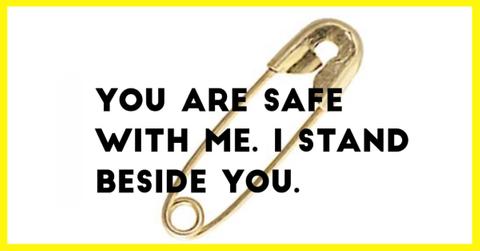Safety Pins Make a Comeback as a Symbol of Support After the 2024 Presidential Election
Many are wearing safety pins after the 2024 election as a symbol of support.
Published Nov. 7 2024, 5:11 p.m. ET
The aftermath of the 2024 election is still unfolding, with reactions reverberating across news reports and communities nationwide. While some celebrate the results, many others are struggling to come to terms with them.
For those who hoped to prevent Donald Trump from securing a second term, the reality of his return to the White House is a bitter pill to swallow— and it's prompting them to take steps that, to some, may seem odd or difficult to understand.
One of the responses to the election has been the return of the "blue friendship bracelet" movement, along with the reappearance of the safety pin — a symbol that became widely recognized after the 2016 election. If you're seeing these symbols more often but aren’t quite sure what they mean, here's what you should know.

What is the meaning of wearing a safety pin?
After the 2016 U.S. election, in which Donald Trump was elected the 45th president, many white individuals began wearing safety pins as a visible sign of their opposition to Trump and the toxic, ultra-conservative rhetoric that surrounded his rise to power.
The safety pin quickly became a symbol of self-identified "allyship" — a way for people to show their support for marginalized communities, including immigrants, people of color, and LGBTQ+ individuals, who were seen as particularly vulnerable in the wake of the election. By wearing the pin, they sought to signal that they stood against hate and discrimination, offering a silent solidarity to those who might feel threatened or unsafe.
Once again, following the 2024 presidential election, in which former president Donald Trump won to become the 47th president, the safety pin has made a return.
In the wake of his victory, many people, especially from marginalized communities, are feeling a deep sense of fear and uncertainty. As a response, some are once again wearing safety pins as a symbol to signal that they are a safe space for others — offering solidarity and support in an anxious and divided political climate.
While it seems like an innocent enough gesture, the safety pin movement jas also sparked criticism. Many argued that wearing the pin was more of a performative gesture than a meaningful act of support. Critics pointed out that simply wearing a symbol did little to address the systemic inequalities and injustices faced by marginalized groups.
Some felt that it allowed individuals to feel good about themselves without taking concrete actions to challenge racism, xenophobia, or homophobia. For others, it was seen as an empty symbol — one that could easily be adopted without any real commitment to fighting oppression or creating lasting change.
As a result, while the safety pin was intended to communicate solidarity, it also raised important questions about what it truly means to be an ally and whether symbolic acts alone are enough to create meaningful progress.
With that said, if you're unhappy with the results of the election, don't just wear your frustration as a badge for others to see — channel that fuel into action! Whether it's through volunteering, organizing, or other forms of activism, real change happens when you take actual steps to shape the world you want to see.
